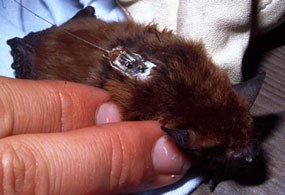
Fun Facts
More than 1,300 bat species exist in the world--only missing from the Arctic and the Antarctic. Yosemite National Park is home to 17 species (25 exist in California and 45 in North America). Bats are the only mammals capable of flight, as the scientific name of their order, Chiroptera, means hand-wing. Two divisions exist to the order, megachiroptera and microchiroptera. Megachiroptera species, found in the Old World, use vision to find their prey while microchiroptera species, found worldwide, use echolocation to find prey. Bats, which are related to primates in an evolutionary sense, might be one of the tinier mammals, but their scientific biology is like the larger mammals: have only one young; young is born at 25% of the mother’s weight; lifespan of 34 years; and gestation 90-100 days. Bats find food by emitting a high-frequency call and using their sensitive hearing to detect echoes from flying insects. The mobility of these remarkable flying mammals enables them to occupy a wide range of habitats. They are found from the lowest elevations in the park to higher than 10,000 feet. They roost in rock crevices and caves, under loose bark and bridges, in attics and tree cavities. North America's largest bat species, the Western mastiff, is a Yosemite resident, as is the spotted bat, with its huge ears and vivid white spots. These, and the Mexican free-tailed bat, are the only bat species in Yosemite whose echolocation calls are audible to the human ear. North American bats undergo torpor or a daily “sleep” state. Bats maintain their body temperature only when active. During the day, while resting, bats let their body temperature drop to the temperature of their surroundings. If the surroundings are cold, bats enter a sluggish state of suspended animation, known as torpor. In order to avoid temperature fluctuations, bats look for locations to roost where they can let the weather regulate their temperatures—typically, in Yosemite, where it is a few degrees above freezing and where the temperature remains stable like in a rock crevice or a sequoia tree cavity. Some of the park’s species, studied as far back as the 1920s by Joseph Grinnell, migrate and some hibernate. At one time, textbooks indicated all bats hibernate, but not all do. 
Park researchers use acoustic equipment to locate bats because scientists generally cannot hear echolocation calls with the naked ear. In addition, radio-tracking devices are attached to individual bats to learn about their roosting locations. Yosemite researchers use 3.5-gram devices applied to a bat’s skin with a bond that only lasts a couple of weeks. Bat experts have identified sequoia groves as potential roosting habitat. Several studies determine at least six species roost in fire-scarred hollows of Yosemite’s sequoia trees. Also, bats use the sequoia canopy to forage—detected by a sound-sensitive balloon released into the tall canopy to track sounds. Yosemite’s scientists also conduct research to determine the elevational distribution of bats. The question has been: Does diet have anything to do with distribution? The way to find out: Analyze guano samples. All North American bats eat insects, which vary at different elevations. The California myotis, for example, eats primarily beetles; therefore, it resides at a low elevation because its select food does not exist at a higher elevation. Other cases are more puzzling to bat experts, however. The little brown bat, which eats small aquatic insects like midges found at all elevations, confines itself to higher elevations and is the only Yosemite bat species to raise its young at an 8,000-foot elevation. Bat Species of Yosemite Little brown bat (Myotis lucifugus) *CSC: California Species of Concern. More Information
References Pierson, E.D.; Rainey, W.E.; & Chow, L.S. (2006, January). Bat Use of the Giant Sequoia Groves in Yosemite National Park. Report prepared for the Yosemite Fund & Yosemite National Park. 146 pp. [64.75 MB PDF] Rainey, W.E.; Ingersoll, T.; Corben, C.J.; & Pierson, E.D. (2009, June). Using Acoustic Sampling of Bat Assemblages to Monitor Ecosystem Trends. Report prepared for the U.S. Geological Survey. 139 pp. [9.5 MB PDF] |
Last updated: November 17, 2025
